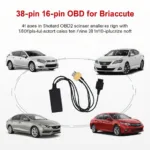Understanding the inner workings of your vehicle was once a mystery reserved for seasoned mechanics. Today, with the advent of On-Board Diagnostics (OBD) readers, car owners can gain insights into their vehicle’s health like never before. But navigating the world of OBD1 and OBD2 readers can feel overwhelming for the uninitiated. This comprehensive guide will delve into the differences between OBD1 and OBD2 readers, helping you determine the right diagnostic tool for your needs.
A Brief History of On-Board Diagnostics
Before diving into the specifics of OBD readers, let’s take a quick look at the evolution of On-Board Diagnostics. The concept emerged in the 1960s, aiming to monitor vehicle emissions. Early systems were rudimentary, offering limited diagnostic capabilities. However, as technology advanced, so did OBD systems. This evolution culminated in the introduction of OBD2 in 1996, revolutionizing car diagnostics.
OBD1 Readers: A Blast from the Past
OBD1, introduced in the late 1980s, marked the first standardized approach to vehicle diagnostics. These systems used a variety of connectors and protocols, making them manufacturer-specific. This lack of uniformity meant that mechanics often needed multiple OBD1 readers to diagnose different car makes and models.
While OBD1 paved the way for onboard diagnostics, its limitations were apparent. The information provided was often cryptic, requiring specialized knowledge to interpret.
OBD2 Readers: The New Standard in Diagnostics
The arrival of OBD2 in 1996 ushered in a new era of car diagnostics. This standardized system mandated a universal 16-pin connector and streamlined communication protocols. This standardization made OBD2 readers compatible with a wide range of vehicles manufactured after 1996, regardless of make or model.
But the benefits of OBD2 extend far beyond compatibility. These advanced systems provide a wealth of data, including:
- Real-Time Data: Monitor engine speed, temperature, oxygen sensor readings, and more, providing valuable insights into your engine’s performance.
- Diagnostic Trouble Codes (DTCs): Identify specific issues within your vehicle’s systems, helping pinpoint the root cause of a problem.
- Freeze Frame Data: Capture a snapshot of your engine’s parameters at the time a fault code was triggered, aiding in diagnosis.
Do You Need an OBD1 or OBD2 Reader?
Choosing the right OBD reader depends primarily on the year your vehicle was manufactured:
- Vehicles manufactured before 1996: Likely require an OBD1 reader. Due to the lack of standardization, you’ll need a reader specifically designed for your vehicle’s make and model.
- Vehicles manufactured after 1996: Compatible with OBD2 readers. These versatile tools offer comprehensive diagnostics for a wide range of vehicles.
Beyond the Basics: Advanced Features of OBD2 Readers
Modern OBD2 readers go beyond basic diagnostics, offering a range of advanced features, including:
- Wireless Connectivity: Connect to your smartphone or tablet via Bluetooth or Wi-Fi, providing access to a wealth of apps and software for data analysis and monitoring.
- Live Data Logging: Record and track engine parameters over time, allowing you to monitor performance trends and identify potential issues before they become major problems.
- Emission Readiness Checks: Verify if your vehicle’s emissions systems are functioning correctly, ensuring you’re prepared for emissions testing.
OBD Readers: Empowering Car Owners
OBD readers, particularly OBD2 readers, have democratized car diagnostics, providing car owners with an unprecedented level of control and understanding over their vehicles. Whether you’re a DIY enthusiast looking to troubleshoot minor issues or a car owner who wants to stay informed about their vehicle’s health, an OBD reader is an invaluable tool.
“Investing in a quality OBD2 reader is like having a personal mechanic in your pocket,” says Emily Carter, a certified automotive technician with over 15 years of experience. “It empowers car owners to take control of their vehicle’s maintenance, saving them time and money in the long run.”
FAQ: Common Questions about OBD1 and OBD2 Readers
1. Can I use an OBD2 reader on my older car with an OBD1 system?
No, OBD2 readers are not compatible with OBD1 systems. You’ll need a dedicated OBD1 reader designed for your specific vehicle’s make and model.
2. What is the difference between a code reader and a scan tool?
Code readers are basic devices that can read and clear diagnostic trouble codes (DTCs). Scan tools offer more advanced functionalities, including live data streaming, component activation, and access to manufacturer-specific codes.
3. Can an OBD2 reader fix my car?
No, an OBD2 reader is a diagnostic tool, not a repair tool. It helps identify issues but doesn’t fix them. You’ll need to address the underlying mechanical or electrical problems to resolve the issue.
4. Where can I find reliable OBD2 software or apps?
There are numerous reputable OBD2 apps available on both Android and iOS platforms. Some popular options include Torque Pro, OBD Fusion, and Car Scanner ELM OBD2.
5. Are there any risks associated with using an OBD reader?
Using an OBD reader is generally safe. However, it’s essential to purchase from a reputable manufacturer and avoid tampering with your vehicle’s systems beyond your expertise.
Conclusion
From the rudimentary systems of OBD1 to the sophisticated capabilities of OBD2, onboard diagnostics have come a long way. Understanding the differences between OBD1 and OBD2 readers is crucial for choosing the right diagnostic tool for your car. If you own a vehicle manufactured after 1996, an OBD2 reader is an essential investment, empowering you to take control of your car’s health and maintenance. For guidance on specific OBD2 reader models and their features, explore our in-depth reviews and comparisons on OBDFree.
Remember, knowledge is power when it comes to car care. Equip yourself with the right diagnostic tools and information to keep your vehicle running smoothly for years to come.


